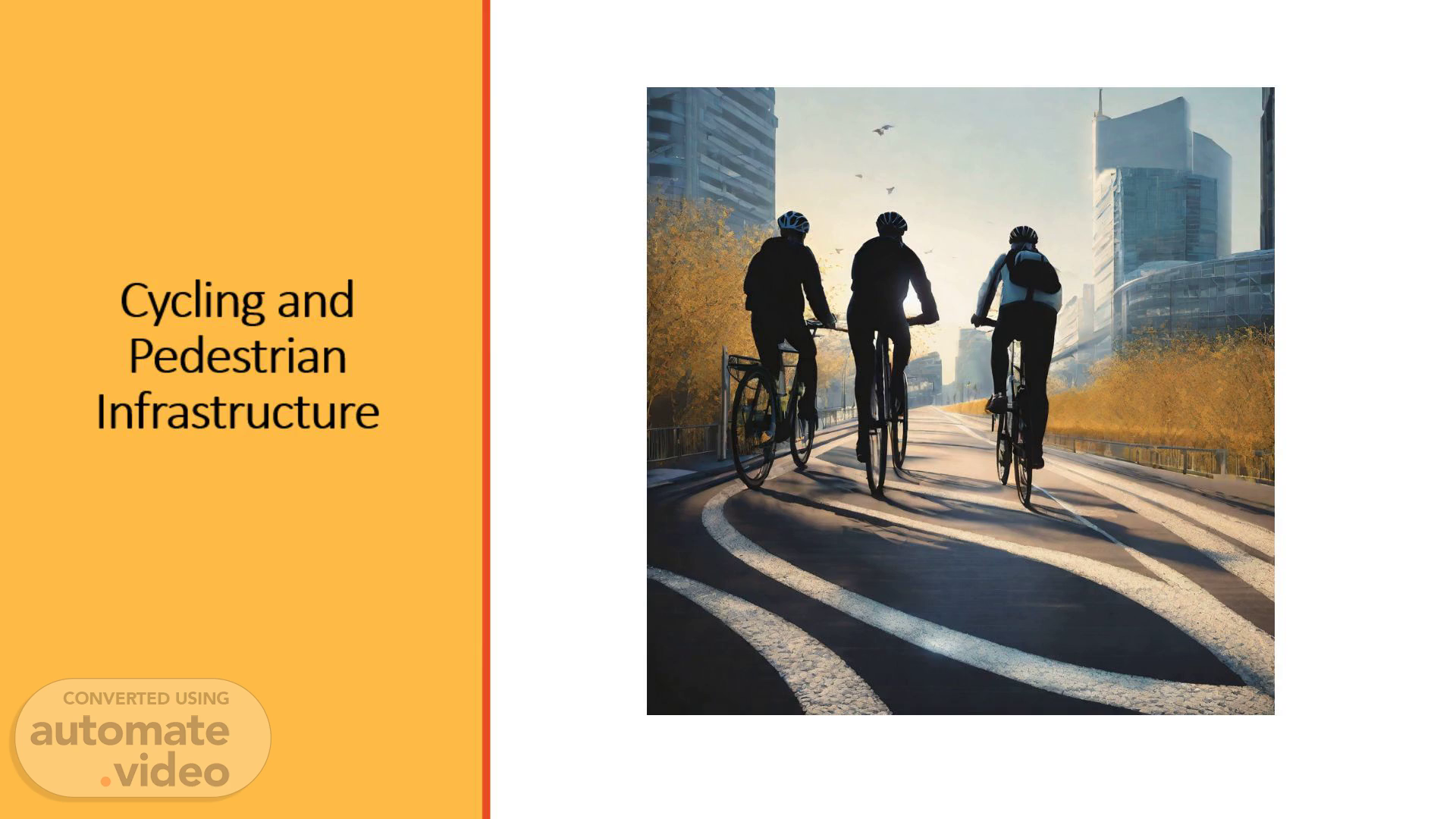
Cycling and Pedestrian Infrastructure
Scene 1 (0s)
[Audio] Good morning everyone. Today I'm here to talk to you about cycling and pedestrian infrastructure. I'll be discussing the advantages and difficulties of establishing such infrastructure in our communities, and what that can bring us. Let's begin..
Scene 2 (18s)
[Audio] An overview of cycling and pedestrian infrastructure is provided here, referring to the physical facilities and services designed to meet the needs of both cyclists and pedestrians in various settings. This infrastructure has a great importance in promoting travel that is safe, accessible, and enjoyable for all..
Scene 3 (39s)
[Audio] Choose cycling and walking for your daily activities and benefit your physical and mental health as well as of your community. Doing so, you can reduce traffic congestion and carbon emissions. Additionally, reduce the risk of chronic diseases, boost your mood and promote social interactions. Get the health benefits of being active outdoors and discover local businesses and parks you won't find any other way. Make cycling and walking part of your daily routine and start reaping the rewards..
Scene 4 (1m 13s)
[Audio] Cycling and Pedestrian Infrastructure plays a major role in our transportation system, but there are numerous hindrances and hindrances that impede improvement. Motorists and local businesses may object to increased traffic congestion or reduced parking, leading to difficulty in overcoming resistance. Insufficient funding is another issue, as sufficient funds must be set aside for projects and maintenance. Moreover, comprehensive planning and coordination is needed to realize cycling and pedestrian infrastructure, necessitating the cooperation of multiple stakeholders..
Scene 5 (1m 51s)
[Audio] When it comes to cycling and pedestrian infrastructure, dedicated lanes for cyclists and pedestrians are often lacking, leading to a decrease in safe and confident travel. Moreover, the infrastructure is often not interconnected, hindering people from moving between different destinations. Clear and visible signage for cyclists and pedestrians is also often scarce, resulting in confusion and difficulty when navigating. It is apparent that improved cycling and pedestrian infrastructure is needed to facilitate active transportation..
Scene 6 (2m 28s)
[Audio] In order to create safe, active and healthy transportation options in communities, cities should provide infrastructure designed for cycling and pedestrian traffic. This infrastructure could include dedicated bike lanes, pedestrian crosswalks and shared-use paths. Bike lanes provide cyclists with a safe environment to ride in that is separate from motorized traffic. Pedestrian crosswalks give pedestrians a safe way to cross the road at intersections. Lastly, shared-use paths offer non-motorized transportation space for cyclists and pedestrians. This type of infrastructure can help promote cycling and walking in cities by making it easier for people to travel without any obstacles or danger..
Scene 7 (3m 17s)
[Audio] Cycling and Pedestrian Infrastructure plays an important role in sustainable mobility and safety. Governments and municipalities should implement traffic calming measures, such as speed bumps, roundabouts and traffic islands, to create safe and convenient infrastructures for cycling and pedestrian. To ensure safety, clear and visible signage must be installed to indicate cycling and pedestrian routes, crossings, and shared spaces. Moreover, it is important to promote safe cycling and walking practices through educational programs and public awareness campaigns, in order to improve the safety of these road users and create a healthier, more sustainable environment..
Scene 8 (4m 1s)
[Audio] Investing in cycling and pedestrian infrastructure can have a significant positive effect on public safety and transportation habits. Amsterdam, Copenhagen, and Portland have experienced this firsthand. Amsterdam is now well-known for its expansive network of cycling lanes and pedestrian-friendly streets. Copenhagen has dedicated cycling lanes and traffic signals for cyclists. Portland has implemented bike lanes, pedestrian-friendly streets, and bike-sharing programs, making it more walkable and significantly boosting cycling rates. These case studies show the powerful effects that investing in cycling and pedestrian infrastructure can have..
Scene 9 (4m 47s)
[Audio] An increase in funding, comprehensive plans and design guidelines, and engagement with local communities are all necessary to improve cycling and pedestrian infrastructure. Increased funding will enable construction of new bike lanes, sidewalks, and crosswalks, as well as the maintenance and repair of existing infrastructure. Comprehensive planning and design guidelines will guarantee the needs of cyclists and pedestrians are met. Engaging with local communities is crucial to address concerns and ensure improvements meet the needs and preferences of the community. These three elements are essential for the creation of safer and more accessible infrastructure for pedestrians and cyclists..
Scene 10 (5m 32s)
[Audio] In order to create a sustainable urban environment, bike-sharing programs, bike lanes and pedestrian pathways must be expanded and incorporated into urban development. This will not only improve safety and accessibility for pedestrians and cyclists, but also promote active transportation as a viable and efficient form of transport. Consequently, it is essential that cycling and walking infrastructure is integrated into the development of cities and neighborhoods in order to prepare for a future with sustainable transportation..
Scene 11 (6m 7s)
[Audio] The main focus of Active Transportation is to promote cycling and pedestrian infrastructure. This includes building dedicated bike lanes, pedestrian paths, and bike-sharing stations, as well as improving safety measures such as traffic calming measures and well-lit sidewalks. Furthermore, public awareness campaigns are encouraged to educate and inform the public about the benefits of active transportation in our society. Additionally, sports partnerships are promoted in order to provide incentives such as discounts for cyclists and walkers. Looking ahead, Active Transportation plans to continue to promote cycling and pedestrian infrastructure and public awareness campaigns..